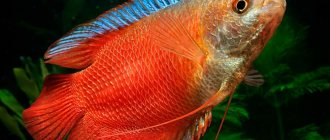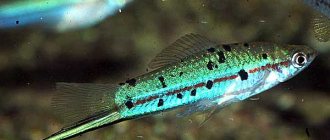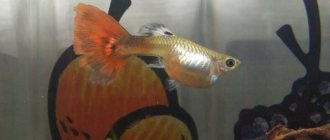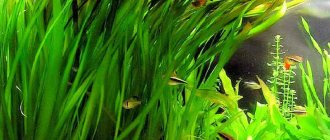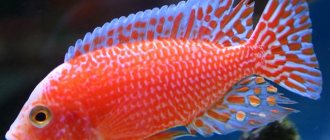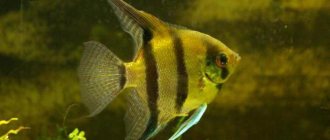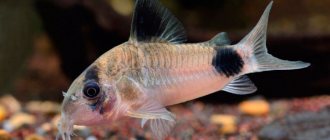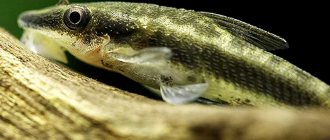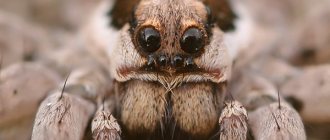Description
The Corydoras catfish has a miniature size, approximately 3–7 cm; specimens with a length of 10 cm have been recorded. The body resembles a spindle, flattened to the tail. The back has a convex shape. The mouth is at the bottom. Near it there are 3 pairs of antennae that help the fish dig up the bottom of its habitat. At home, catfish live up to 15 years.
Corydoras are excellent orderlies: most of the time they dig in the ground, clearing the reservoir of contaminants.
A distinctive feature of the catfish is its shell, consisting of bony plates. They are located on the back in 2 rows. Most often you can find an olive-grayish color or pale pink; sometimes there are white corydoras with red eyes - albinos. Males have brighter colors.
The female catfish is much larger than the male. Its dorsal fin has a rounded shape, while that of the male is sharp. The end of the pectoral fin of the catfish is also sharp, so it can tear the net for catching.
Corydoras in water breathe through gills. To capture air at the surface of the water, they use intestinal respiration.
Choosing the right healthy catfish
Corydoras catfish have a strong immune system. Experts have not identified any diseases inherent in these aquarium fish. Corridors are able to withstand sudden changes in environmental conditions.
However, it is prohibited to use salt (sea salt, table salt) for pest prevention purposes.
When purchasing corydoras, take a closer look at the behavior of the selected specimen:
- It is not recommended to take fish that lie on the ground and do not respond to external stimuli.
- A healthy catfish is active, quickly swims to the surface, takes in air, and then easily swims to the bottom. The sick individual moves hesitantly and chaotically, falls over on one side or lies motionless on the bottom.
Signs of sick fish:
- stuck together fins;
- cloudy eyes with a film;
- damage to the antennae;
- sore or red gills.
Red-brown spots are an indicator of the presence of bacteria or fungi in the fish’s body. The sunken abdomen of the catfish indicates that it is exhausted or infected with helminths. A bulging abdomen may be the cause of some disease.
Do not rush to release new fish into a common tank. Keep them in quarantine for a while.
Thus, Corydoras catfish are schooling, cheerful and interesting fish. If you care for them properly, they will delight their owners for 15 long years.
Types of Corydoras
Experts count more than 150 species of corydoras.
There are a huge number of subspecies of Corydoras catfish
Golden (bronze)
Color – golden with a bronze tint. There is a shiny line on the back. This species is native to Venezuela and Trinidad. An individual can reach a length of 7 cm. The bronze corridor needs a water temperature of 21 to 26°C.
Mottled
This species is most often found among corydoras catfish. The length of the male is on average 5 cm, and the female is 7 cm. The color of the corydoras is olive-gray. Each individual has its own form of black spots located on the body. The fish are unpretentious. Able to withstand temperature fluctuations from 4 to 30 ° C (I hope you won’t check). Speckled catfish reproduce in any conditions.
Panda
The size of this catfish is 3 - 5 cm. The color of the fish is light, sometimes with a pink tint. The catfish has black spots on the dorsal fin and tail, as well as a black mask on the eyes. The coloring gives the species its name. Found in the Peruvian Ucayali River. They love water above 17 °C. They can tolerate temperatures up to 12 °C for no more than 4 hours. They prefer dim light. To live in an aquarium and successfully breed, pandas need clean, slightly acidified warm water (22 ° C), as well as constant aeration.
Shterba
Range: river basin of Bolivia and Brazil. A 5 cm fish with a dotted pattern on its body. On the tail the pattern turns into stripes. The color of this species of corydoras is dark brown. The pelvic fins are bright orange. Adult catfish have red rays on their pectoral fins.
Shterba catfish can change color to match the color of the soil.
Adolfi
A small fish, 5 cm long. It has a light gray color. There is a mask over the eyes, like that of panda catfish. The back of the head is decorated with an orange speck. A longitudinal black stripe runs along the back. Habitat: Rio Negro River. This species requires more careful care and maintenance. It does not reproduce in captivity and lives no more than 6 years. The individual is very shy.
Leopard
Beautiful catfish. The color is brilliant yellow with black spots, similar to a leopard skin. The length of the individual is 6 cm. Another name for the catfish is trilinear, because of the three lines that run across the entire back (in males), from the middle of the back to the tail (in females). Looks interesting against the background of dark gravel.
Venezuela
A type of aquarium fish called Corydoras, which looks like a golden one. The difference is in the larger body and habitat. The Venezuelan catfish lives in the country after which it is named, and the golden catfish lives in Trinidad. It has a bronze color and a turquoise spot on the back.
Corridors Pygmies
Corydoras pygmaeus are so named because of their tiny size of 2.5-3 cm. They look very beautiful in a school when kept in a nano aquarium.
In nature, they mostly live in the coastal silted areas of the Brazilian Rio Madeira River.
The almost transparent body and plumage are colored silver or golden and have a clear dark stripe along the lateral line. Large eyes are sometimes outlined with a blue outline.
Julie's corridors
Corydoras julii is a callicht catfish that is extremely popular in home aquariums.
This species was discovered by researcher Franz Steindachner in 1906, having discovered the fish in the lower reaches of the Amazon. The species is also found in the northeastern rivers of Brazil.
The coloring of the Pantsirnik is very original. The background is cream or light gray with small dark patterns and a stripe along the entire lateral line from the gill plates to the tail feathers.
The fins are white with black stripes; the dorsal fins have a dark spot at the base.
The average size of Julie's catfish is about 5-6 cm.
Corridors Nanus
Corydoras nanus is a small, very active and nimble catfish that lives in the rivers of Suriname and Eastern Brazil. The silvery body, colored in olive shades in the upper part, grows up to 5 cm. On a light background there is a dark and bright, almost black, mesh pattern.
Males, smaller than females, have golden tones in color, the fins are also colored, and the dorsal is black and has a yellow marker at the top.
These fish are often called Moth Corys.
Corridors Arquatus
Corydoras arcuatus is more commonly called Double-banded or Arc-banded. The body (length up to 5 cm) is silvery, shiny, along the entire back there is a wide dark stripe on both sides of the fin. Due to the convex upper part of the Carapace's body, it resembles an arc.
This variety of Corydoras is not so unpretentious to the conditions of detention; they have very sensitive antennae, which are quickly damaged if the water quality is poor.
Corridors Meta
Corydoras metae is named after the Meta River in Colombia, where it was first discovered in 1914.
The main color of the body, the length of which reaches 5.5-6 cm, is reddish-brown with a golden tint. A bright black stripe runs along the entire back, capturing the high back fin. The same, but transverse, crosses the head and eyes of the fish. The plumage has a yellowish-reddish tint, translucent.
Barbatus corridors
Corydoras barbatus naturally lives in rivers flowing in Rio de Janeiro and São Paulo. They grow up to 10-12 cm, although in aquarium conditions they are slightly smaller. The brownish body has a golden tint and is often dotted with dark spots.
How to get offspring
Spawning tank . Sexual maturity in Corydoras catfish occurs at the age of one to one and a half years. To breed them, you will need to prepare a spawning tank. Recommended volume is about 60 l. It must have lighting and aeration. You can equip it with broad-leaved plants, smooth stones and driftwood. In general, the environment in it should be the same as in a regular aquarium. The only thing is that it is better to set the water temperature 1-2 degrees lower.
Spawning . Corydoras are distinguished by group spawning, in which one female and several males participate. It begins with the males actively “chasing” the female throughout the aquarium. After this ritual, she selects one male and collects his milk in her mouth. At the same time, a kind of “bag” is formed from its ventral fins, into which 5 or 6 eggs are deposited. Then the female chooses a place, most often it is an aquarium glass, a piece of driftwood, or a plant leaf, cleans it, lubricates it with milk and glues the eggs there. Then the whole procedure is repeated with the remaining males.
IMPORTANT! Males can eat eggs, so they need to be distracted. To do this, it is enough to give them a lump of fresh tubifex. There is a second option - after the completion of spawning, all adult individuals are transferred back to the aquarium.
The larvae hatch in about a week. When the fry are able to swim, they can be given “live dust”. And after a month they can be placed in a common aquarium.
Interestingly, after 7-10 days, the spawners are again capable of reproduction, and the spawning period itself can last up to a year.
Adolf's corridor.
Conditions of detention
Corydoras catfish are not picky about conditions in the aquarium. The fish are bottom-dwelling, so soil structure and free space are important. For the bottom surface, dark sand or fine gravel with smooth edges is suitable. Live plants, mosses and ferns, bushes are suitable. With a strong root system so that the aquarium fish Corydoras does not undermine the plant.
It is better to keep catfish in groups of 5–8 individuals. Do not use table or sea salt to treat neighboring fish.
Character of the Corydoras
Corydoras aquarium fish have a peaceful disposition. They get along well with any aquarium inhabitants, except aggressive predators, such as cichlids. They feel bolder in a company of 5–8 catfish. They love to hide in shelters. Digging in the ground is the main activity of Corydoras. They rarely rise to the surface of the water.
Requirements for an aquarium
When selecting an artificial home pond for a corydoras, consider the number of fish that will live in it. A large aquarium is not needed. For a group of up to 8 individuals, the volume is 50–60 liters. For catfish, the bottom is important, where they swarm, so that each member of the group has enough space.
For lighting, use dim lamps or create shading in the aquarium with floating plants. Decorative driftwood and caves would be a great design. When installing them, make sure that there is room for each fish to dig into the ground.
An aquarium needs an aerator and a filter. The amount of water should allow the Corydoras to swim to the surface for a breath of fresh air.
Aquarium water parameters
The water in an aquarium for catfish must meet the following criteria:
- Water temperature 22–26 °C.
- Acidity 5.5–8.0 pH.
- Hardness 5–18 dH.
Change a quarter of the water in the aquarium every week. Clean the soil every 14–15 days. Make sure that there are no sharp pebbles or fragments of decorations at the bottom, which could damage the mouth or antennae of the corydoras.
Lifespan
In an aquarium, catfish live from 10 to 12 years. There are cases when they lived up to 15–20 years.
Habitat in nature
The term Corydoras comes from the Greek words kory (helmet) and doras (skin). Corydoras is the largest genus among neotropical fishes, it includes more than 160 species.
There is still no reliable classification of these species. Moreover, some fish in the past belonged to other genera, but today they have been transferred to Corydoras. This is what happened with the genus Brochis.
Corydoras are native to South America, where they are found east of the Andes to the Atlantic coast, from Trinidad to the Rio de la Plata in northern Argentina. They are not found only in Panama.
Corydoras usually live in small rivers, tributaries, swamps and ponds in South America. These are places with a quiet current (but rarely with standing water), the water there is very muddy, and the depths are shallow. The banks are covered with dense vegetation, and aquatic plants grow just as densely in the water.
Most Corydoras species live in the bottom layer, burrowing in gravel, sand or silt. They live in bodies of water with different parameters, but prefer soft, neutral or slightly acidic water. The usual water hardness is 5-10 degrees.
They can tolerate slightly salty water (with the exception of some species), but do not live in places where rivers flow into the ocean.
Most often they live in schools, which can number hundreds, and sometimes thousands of fish. As a rule, a school consists of fish of one species, but sometimes they mix with others.
Unlike most catfish, which are clearly nocturnal species, Corydoras are active during the day.
Their main food is various insects and their larvae that live on the bottom, as well as plant matter. Although Corydoras are not scavengers, they can eat dead fish.
Their feeding method is to search for food at the bottom using sensitive whiskers, and then suck the food into their mouth, often plunging into the ground up to their eyes.
What to feed Corydoras
Corydoras are unpretentious in food. They use what they find at the bottom.
As food the fish are given:
- daphnia;
- bloodworm;
- catfish tablets with herbal ingredients;
- tubifex (live or frozen);
- worms (whole or cut).
Fish also love dry and granular food.
Food for platidoras, as for other bottom-dwelling fish, should be chosen submersible.
Feeding
They eat from the bottom, while being extremely unpretentious to food. They eat special pellets for catfish well, they love live and frozen food - tubifex, bloodworms.
The only thing you need to worry about is that the food gets to them. Since most often other fish live in the middle layers of water, mere crumbs can fall to the bottom.
The most important and dangerous misconception is that catfish eat waste from other fish; they are scavengers. This is wrong. Corydoras are complete fish that require a varied and nutritious diet to live and grow.
Character and relationships with neighbors
The aquarium fish Corydoras has a calm disposition. Feels good in a flock of 5–8 individuals. Most of the day the fish is at the bottom of the tank.
Corydoras in the waters of a community aquarium are compatible with fish of the same size, these are:
- guppy;
- platies;
- gourami;
- discus;
- zebrafish;
- angelfish;
- swordtails;
- mollies;
- cockerels (in a large aquarium), etc.
Before choosing neighbors, check out the table!
Mastacembelus, eels, shrimp, astronotus are not the best companions for corydoras. Catfish should not be housed with cichlids or Koi carp. Corydoras is not compatible with any aggressive aquarium predators.
Compatibility
Corydoras in their natural habitat live in flocks, which can have either several members or a large number of them (up to 20-50). Therefore, it is not recommended to place Shellfish in a home tank alone; they will look timid and fearful, feel uncomfortable, and become stressed.
It is better to place a group of 8-10 catfish, but there should be at least 5 of them, with more males than females.
Corydoras is a peaceful fish; it gets along well with any non-aggressive species of underwater inhabitants - angelfish, zebrafish, swordtail, botia, barb, discus, guppies, gourami, mollies, platies, plecostomus, iris, rasbora, labeo, tetra.
Conflicts may arise with ancistrus if there is not enough bottom area.
They can easily move into an already working aquarium with neighbors. The main thing is that there are no goldfish, mastacembelus, astronotus, cichlids, Koi carp and other large predatory species there.
Corydoras diseases
Often catfish get sick from unsuitable or spoiled food. The source of the disease can be plants and soil. Large shells with sharp edges injure the fish, and then a bacterial infection occurs. Any helminthic infestation will end in the death of the Corydoras, since there is no treatment.
Carnophylliosis
The fish becomes infected by feeding on the tubifex, which contains white worms up to 2.5 mm in size (tapeworms). Parasites burrow into the soil of the aquarium. Once in the intestines of the catfish, the worms secrete poison and the fish dies from hunger and poisoning. The disease has no cure. Infestation can be prevented by cutting open and holding up live and dead tubifex worms and holding them up to light. If worms are found, the food is destroyed.
Reviews
Due to its ease of care, resistance to disease, and peaceful nature, the catfish will be a wonderful gift for both a beginner and an experienced aquarist. Even looking after 4-5 individuals, which are recommended to be launched at the same time, will not be difficult. In addition, Corydoras can pick up food after other fish, which is what earned it the nickname - the aquarium scavenger. You can buy catfish at any pet store, thanks to the abundance of species, everyone will find something of their own. With proper care, this cheerful and active inhabitant of the aquarium will delight its owner for many years.
Do you want to buy Corydoras catfish for your aquarium? Share in the comments!
Adviсe
- When changing water, also clean the soil. Pandas don't like pollution.
- Fish prefer dark-colored sand to light-colored sand.
- Dry oak or beech leaves are beneficial for the health of catfish.
- Catfish will get along with all peaceful fish and even shrimp.
- It is optimal to use Java moss for spawning.
- Some sources indicate that catfish can live in a small container. This will cause discomfort to the fish, adhere to the recommended parameters.
- In fry up to 3 months the color is not expressed. Don't go wrong with the breed when purchasing.
Peaceful, hardy and easy to keep, the panda catfish is suitable for beginner aquarists. Thanks to its unusual color, the catfish has confidently occupied a niche among popular fish.
Sources
- https://rybkies.ru/rybki/som-koridoras.html
- https://RybkiVBanke.ru/akvariumnye-rybki/koridoras
- https://MrHvost.com/vse-vidy-koridorasa
- https://fishcam-store.ru/rybki/som-panda.html
- https://sazhaemvsadu.ru/koridorasyi-soderzhanie-i-razvedenie/
- https://aquaspecial.ru/akvariumnye-rybki/som-koridoras
[collapse]


